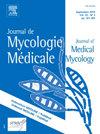Disseminated histoplasmosis in a 4-month-old infant presenting with prolonged fever and pancytopenia: A case report
IF 1.8
4区 医学
Q3 MYCOLOGY
引用次数: 0
Abstract
Background
Histoplasmosis is the most prevalent endemic mycosis in the United States, typically affecting immunocompromised individuals. Diagnosis of histoplasmosis in immunocompetent patients is rare, particularly among young infants, with only a few cases reported.
Case presentation
We present a 4-month-old female with a history of prematurity who initially presented with 11 days of fever. She visited her local emergency department, where she was diagnosed with Rhino/enterovirus bronchiolitis. Pancytopenia was noted at that time, attributed to viral bone marrow suppression. Persistent fever and pancytopenia led to her transfer to our hospital for further evaluation and treatment. On admission, she exhibited hepatosplenomegaly, pancytopenia, elevated procalcitonin, and lactate dehydrogenase levels. Additionally, T cell deficiency was observed. Initially, there was concern for hemophagocytic lymphohistiocytosis; however, bone marrow biopsy and aspirate confirmed T cell deficiency. As fever persisted on day 19, further investigations were conducted, including a positive beta-D-glucan assay. Subsequent urine and serum Histoplasma antigen tests were positive, with metagenomic sequencing confirming the diagnosis of histoplasmosis. Treatment comprised one week of amphotericin B followed by three months of oral itraconazole. Resolution of fever, pancytopenia, T cell deficiency, and hepatosplenomegaly occurred, and the patient has shown no signs of recurrence to date.
Conclusions
This case serves as a reminder to clinicians regarding the necessity of considering disseminated histoplasmosis in young infants who present with fever of unknown origin, pancytopenia, and hepatosplenomegaly, despite its rarity. Failure to do so can lead to fatal outcomes.
一名 4 个月大的婴儿感染播散性组织胞浆菌病,表现为长期发热和全血细胞减少:病例报告。
背景:组织胞浆菌病是美国最流行的地方性真菌病,通常影响免疫功能低下的个体。在免疫功能正常的患者中,组织浆菌病的诊断是罕见的,特别是在年幼的婴儿中,只有少数病例报道。病例介绍:我们报告一名4个月大的女性,有早产史,最初表现为11天发烧。她去了当地的急诊科,在那里她被诊断为犀牛/肠病毒细支气管炎。当时注意到全血细胞减少,归因于病毒骨髓抑制。持续发热和全血细胞减少导致她转到我们医院进一步评估和治疗。入院时,她表现出肝脾肿大、全血细胞减少、降钙素原升高和乳酸脱氢酶水平。此外,观察到T细胞缺乏。最初,人们关注的是噬血细胞性淋巴组织细胞增多症;然而,骨髓活检和抽吸证实T细胞缺乏。由于发烧持续到第19天,进行了进一步的调查,包括β - d -葡聚糖检测阳性。随后尿液和血清组织浆体抗原检测呈阳性,宏基因组测序证实了组织浆体病的诊断。治疗包括一周两性霉素B,随后三个月口服伊曲康唑。发热、全血细胞减少、T细胞缺乏和肝脾肿大消退,患者至今未出现复发迹象。结论:该病例提醒临床医生,在出现不明原因发热、全血细胞减少和肝脾肿大的婴幼儿中,有必要考虑播散性组织胞浆菌病,尽管这种情况很少见。如果不这样做,可能会导致致命的后果。
本文章由计算机程序翻译,如有差异,请以英文原文为准。
求助全文
约1分钟内获得全文
求助全文
来源期刊
CiteScore
5.10
自引率
2.80%
发文量
68
审稿时长
6-12 weeks
期刊介绍:
The Journal de Mycologie Medicale / Journal of Medical Mycology (JMM) publishes in English works dealing with human and animal mycology. The subjects treated are focused in particular on clinical, diagnostic, epidemiological, immunological, medical, pathological, preventive or therapeutic aspects of mycoses. Also covered are basic aspects linked primarily with morphology (electronic and photonic microscopy), physiology, biochemistry, cellular and molecular biology, immunochemistry, genetics, taxonomy or phylogeny of pathogenic or opportunistic fungi and actinomycetes in humans or animals. Studies of natural products showing inhibitory activity against pathogenic fungi cannot be considered without chemical characterization and identification of the compounds responsible for the inhibitory activity.
JMM publishes (guest) editorials, original articles, reviews (and minireviews), case reports, technical notes, letters to the editor and information. Only clinical cases with real originality (new species, new clinical present action, new geographical localization, etc.), and fully documented (identification methods, results, etc.), will be considered.
Under no circumstances does the journal guarantee publication before the editorial board makes its final decision.
The journal is indexed in the main international databases and is accessible worldwide through the ScienceDirect and ClinicalKey platforms.

 求助内容:
求助内容: 应助结果提醒方式:
应助结果提醒方式:


